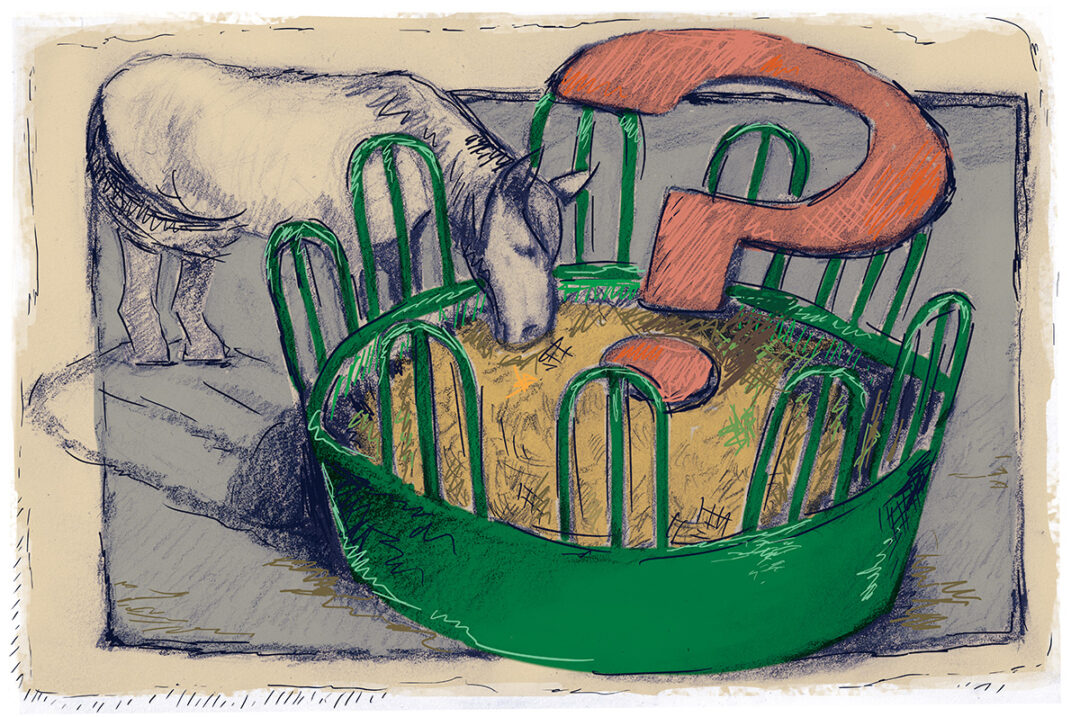Horse owners are often labeled as finicky when buying hay. Many forage buyers and sellers equate “horse-quality” hay to forages with the highest nutrient content, especially in comparison to “cow hay.” This descriptor is a source of confusion in the industry because cow hay can refer to anything from relatively indigestible, mature hay fed to beef cattle to dairy-quality alfalfa, which has a protein content above any horse’s requirements.
So what constitutes horse-quality hay, and how can understanding the myths that drive buying trends help buyers and sellers navigate the market?
First, it helps to understand two simple truths about horse hay. We know that all hay intended for horses should be sweet-smelling, dry and mold-free, with a high leaf-to-stem ratio. Easy enough, right? But the full answer is much more nuanced. Every horse is different, and very few owners are as educated as the nutritionists and veterinarians who make dietary recommendations.
Instead, nutrition fads and myths influence hay-buying trends, bringing us to our second truth regarding horse hay. Hay producers are one of the most frequently used sources of information for buyers. Producers can capitalize by responding to these trends with education to quash myths and by building relationships with buyers to provide personalized insight into their unique needs.
Myth: Horses must have higher-quality hay than cattle
In reality, the needs of individual horses mean that there is no one-size-fits-all standard for hay quality. This is complicated by the fact that cow hay is poorly defined and misunderstood by many buyers. As ruminants, cattle can digest and utilize fiber more efficiently than horses, which are hindgut fermenters and rely on the large intestine to digest fiber. Horses are also less equipped to tolerate mold than cattle, which contributes to the popular notion that the same hay cannot be suitable for both cattle and horses.
It’s true that no horse owner should feed moldy hay, nor should they feed low-quality hay indiscriminately. Despite this, some horses thrive on more fibrous hay, especially "easy keepers," overweight horses and horses with certain metabolic conditions. Hay producers can start conversations with horse owners to determine if more fibrous hay is appropriate for their needs, and an equine nutritionist can confirm whether a lower-quality forage would benefit individual horses.
Myth: Alfalfa is too rich to be safe for horses
Some horse owners wrongly assume that alfalfa is too nutrient-rich for horses, believing that it exacerbates behavioral problems. In reality, when properly incorporated, alfalfa is a valuable forage for horses. Alfalfa is highly digestible, palatable and an excellent source of protein. This excess protein is not readily converted to energy by horses and will instead be excreted as ammonia. Therefore, excess protein in the diet is not to blame for "hot" horses.
As with all feedstuffs, it is important to balance the ration for the individual. For growing foals and broodmares, alfalfa is an especially appealing option to provide digestible protein. Mixed alfalfa-grass hay is a great option for many mature horses. Understanding the energy and protein requirements of the different classes of horses can help producers market their products to horse owners who are uneducated about alfalfa.
Another fear associated with alfalfa is a fear of increased colic concerns. This can be a difficult myth to break down because horse owners rightfully fear colic. The nutrient content of alfalfa hay is very different from other forages like mature grass hay, and switching quickly does put horses at risk, especially because many horses will consume more free-choice alfalfa than grass hay due to its palatability. But it is important to note that the real danger is in the feeding practice. As with any diet change for horses, it is the responsibility of the horse owner to incorporate alfalfa slowly and in the proper amounts to safely benefit from its value.
Myth: First-cutting hay is always the worst
First-cutting hay of cool-season grasses often contains seedheads, which leads to higher yields for the producer at the expense of creating more fibrous hay than later cuttings. Because of this, first-cutting hay is widely perceived as low-quality and subsequent cuttings, especially second-cutting hay, are accepted as inherently higher quality.
Truthfully, the most important factor determining hay quality is the stage of maturity. So first-cutting hay may well be higher quality if the producer chooses to forgo higher yields and cut the hay at an earlier stage of maturity. Similarly, subsequent cuttings may be lower quality if the producer waits to cut and bale hay.
Other factors influencing hay quality include the time of day that the hay was cut, storage conditions and hay-making decisions. A better indicator of quality hay is a visual inspection of the hay for color, scent and leaf-to-stem ratio. The best indicator of hay quality in any situation, though, is a forage analysis.
Buyers limit themselves by writing off first-cutting hay and may unknowingly buy poor-quality hay solely because it is second cutting. Buyers and sellers alike would benefit from education about the truth behind this myth.
Myth: There is one ideal species of hay
The idea that one type of hay is better than all others is frequently perpetuated by horse owners who had bad experiences after moving to regions with hay that they were not accustomed to, or whose individual horses did not perform well after a change. Despite these circumstances, there is no one ideal forage type for all horses. Many species of grass and legume hays have similar nutrient profiles to each other, and the quality of any hay has less to do with species and more to do with the stage of maturity, storage practices and handling of the hay.
Horse hay buyers benefit from remaining open-minded and building relationships with reputable producers. Producers, for their part, should capitalize on every opportunity to educate themselves and their buyers to market their products and expel damaging fads in equine nutrition.
The moral of the story is: When it comes to hay quality, evaluating the needs of the individual horse is imperative. For producers, getting to know buyers and their unique needs can help to break down myths and form better relationships.










